
Application and measurement tasks
Many industries and sectors of process automation have relied on the radiometric method for the most difficult level measurement tasks for decades. The physical principle permits the determination of levels and changes in density from the outside through any tank geometry and material. The success and acceptance of this procedure are inherent in its extraordinarily high degree of dependability. From the perspective of measurement technology, the use of gamma radiation constitutes the ideal method. It is not impeded by the well-known limitations of conventional measurement methods, eg
* High tank pressures and temperatures.
* Physical - particularly changing and thus problematic - product properties.
The method is simply ideal in toxic or absolutely sterile processes, in case of baffles like agitator blades or complicated tank geometries. Radiometric systems are typically employed when conventional measurement methods fail or cannot guarantee sufficient functional safety. Therefore, this measurement technique is not only used in the processes of large chemical or petrochemical facilities but also in other industries like the pulp & paper industry, the offshore and oil industry or in cement, power and sewage treatment plants. It is employed for the most varied measurement tasks:
1. Level limit detection - when the minimum or maximum (overspill protection) level is to be monitored in a tank.
2. Continuous level measurement - when the level is to be displayed for the whole measuring range.
3. Interface measurement - for the detection of interface layers in the gravimetric separation of emulsions (eg the separation of water and oil).
4. Density and mass flow measurement - for the noninvasive recognition of different liquid media or for the measurement of solids in liquids.
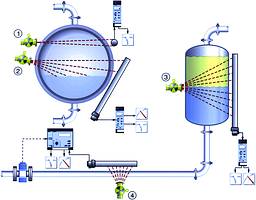
Safety and radiation protection
Radiation protection works according to the ALARA principle (as low as reasonably achievable) worldwide. This entails that all measures are taken to keep the exposure to radiation as low as possible. One has to take into consideration that the presently permitted limits will be tightened by new radiation protection legislation. Therefore, Endress+Hauser has assumed the task of solving applications with the lowest possible source activity and thus minimum radiation exposure. On the one hand, this is achieved by the high degree of response sensitivity of the scintillation detector, resulting in the natural radiation at an altitude of approximately 3000 m being more intensive than the radiation typically required for measurement (see diagram: Comparing cosmic radiation). But also in respect of the source Endress+Hauser offers maximum safety. The company uses 137Cs (Caesium) instead of 60°C sources in approximately 80-90% of all applications. And this for two reasons: First of all, 137Cs sources can be screened better than cobalt in the container (which means no or only a minimum control area) and, secondly, no exchange of the source is required during the serviceable life of a radioactive source of approximately 15 years. Co sources require an exchange after approximately seven years because of their shorter half-life value entailing additional exposure to radiation. The isotope itself has the highest classification worldwide. This guarantees maximum source protection. In addition, these sources are safely 'packed' in containers that offer, apart from their screening effect, also protection against mechanical and chemical influences. With the new QG 2000 source container and its maximum screening effect the company is complying, already today, with the requirements in radiation protection of tomorrow.
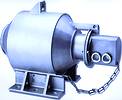
People are continuously exposed to radiation caused by nature and civilisation
Ever since human beings have walked the earth they have been living under the influence of natural ionised radiation from the sun and the depth of the universe and from naturally occurring radioactive deposits in the soil and rocks of the earth's crust. In addition to this external radiation to which people are exposed there is also an internal one caused by natural radioactive materials, which are absorbed via the food chain.
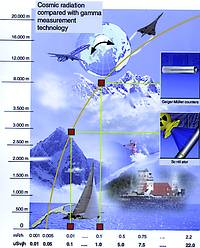
Apart from this natural exposure to radiation, people are also subjected to radiation caused by civilization in which the biggest portion is the result of medical x-ray examinations. The pictures show that we are exposed to radiation everywhere and that we are able to cope with it. They also serve to 'give us an idea' as to how low the share of radiometric measurement technology (less than 1%) is in comparison with the overall radiation exposure.
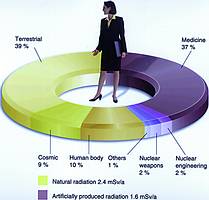
Operating principle
The gamma source emits radiation that is attenuated as it passes through materials. A detector, mounted on the opposite side of the vessel or pipe, converts this radiation into an electrical signal. The strength of the signal is determined by the distance between the radiation source and the detector, and also the thickness and density of the material. The distance and the vessel or pipe walls through which the radiation penetrates are constant values. These must be included in the calculation when selecting the strength of the radiation source. The actual measuring principle is based on the absorption of radiation by the product to be measured.
Measurement system
In radiometric measurement technology, four components are required in most cases:
* Radioactive source.
* Source container.
* Detector.
* Transmitter.
Source
The artificial 137Cs and 60Co radioisotopes, which are pure g-sources, are predominantly used for level and density measurement facilities. This eliminates any contamination of the product or the tank walls - even over a period of many years.
The radioactive material, both 137Cs and 60Co, is used in a double-walled, welded enclosure of stainless steel. The strain on the sources is classified in accordance with ISO 2919. Classification C 66646 corresponds to the highest degree of protection in respect of temperature, pressure, shock, oscillation and puncture.
Source container
In order to prevent radiation in directions other than towards the sensor, the source has been integrated into a container. A radioactive source, like a light, radiates equally in all directions (divergently). In radiometric measurement, however, only a narrow beam is desired in the direction of the detector. Therefore, the source containers have different outlet angles for optimum adaptation to the respective application.
The source container consists of a completely welded enclosure of stainless steel filled with lead, which is a favourable screening material because of its high specific mass. The steel housing not only protects against mechanical damage, it also provides sufficient protection in case of fire. Lead melts at 327°C but still keeps its screening effect in this condition and cannot escape from the source container because of the completely closed housing. The radioactive source is contained in a support, which in turn is housed in the container. It may be locked in both switching positions (On/Off). The source support is protected by seals against the penetration of dust, dirt and liquids.
Different design sizes - with different screening effects - are available in dependence on the required source activity. An incombustible design (tested at 1000°C for one hour) may be used in particularly critical facilities.
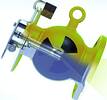
Detectors for level limit applications (Geiger-Müller counter)
A strong electric field prevails in a counter tube filled with inert gas in which a particle ionised by radioactive radiation triggers an avalanche of ions. These discharges are counted as current pulses by the evaluation electronics. They are dependent on the number of occurring gamma quanta and thus directly on the dose rate at the counter tube.
For level, interface layer and density measurement (Rod scintillation detector)
The high degree of response sensitivity facilitating the lowest possible source activities open up a wide range of applications.
Scintillation is what occurs when radioactive radiation impinging upon fluorescent substances (scintillators) and photons of light are liberated. These photons reach a photo multiplier, and are amplified, then detected as electrical pulses. The number of pulses corresponds to the incident radiation intensity. Even in cases of very low dose rates at the scintillator, the high gain of the photomultiplier offers a high degree of accuracy as substantial pulse rates can still be produced.

Monitoring system of the rod scintillator
A closed, active monitoring circuit with a reference pulse continually monitors the whole detector and guarantees an immediate and defined error message in case of an alarm. It simultaneously ensures the compensation of long-term stability and the effects of temperature.
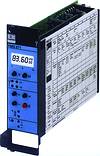
Transmitters
One of the functions of the transmitter is to supply the required voltage to the detectors. Intrinsically safe detector circuits serve to comply with the requirements of explosion protection. Depending on the application, the Gammapilot FTG transmitters with relay outputs for level limit detection and the Gammasilometer FMG with analogue outputs for continuous level, interface layer or density measurement are available.
In addition, these instruments offer the possibility of electronic linearisation. Further functions like the safety-focused selection of the relay actuation and outputs in case of an alarm as well as the source disintegration compensation have been implemented. Additional interface cards permit the integration of the switching units into higher-ranking automation systems.
Processes that interfere with radiometric measurement systems
Gammagraphy operations (as used in non-destructive material tests) have a strong influence because they affect the detector with brief but intensive external radiation. Special software evaluation makes it possible to recognise this condition and to arrest the output signal of the measurement system during the gammagraphy operation.
Outlook
Legal provisions and certain reservations about handling radioactive material impede the application of radiometric measurement systems. Nevertheless, one cannot judge at present as to when another physical measuring method will significantly substitute radiometric measurement. The big advantage of radiometric level measurement is constituted by the fact that this measuring system works absolutely noninvasively and without any mechanically moving parts. For the user, this provides a high degree of operational safety and reliability of the measuring system with minimum maintenance and service expenditure, even under the most extreme process conditions. Radiometric measurement technology will continue to maintain its position as a respectable, safe and reliable measurement technique, just as it is true for medical x-ray examinations.
Endress+Hauser
(011) 262 8000

© Technews Publishing (Pty) Ltd | All Rights Reserved